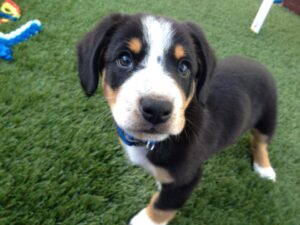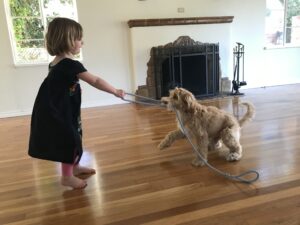Before you decide to get a puppy (or dog) and bring this bundle of wags home with you, there a number of things to be considered!
Can you even get a puppy?
-
- Do you have the landlord’s permission? If you own your home, you can give yourself permission, but if you rent, you must have the permission of your landlord to have a dog – or you might find yourself scrambling to find yourself a new home (or return or rehome your dog)
- Is every member of the household on board? Make sure that everyone is ready and eager to be a pet owner. Young children may be eager, but might not be ready for dealing with a dog. Keep in mind that young puppies (under 5 months) are often mouthy and bitey, exploring the world and playing with their companions – including your toddler – with needle-sharp teeth. And caring for the dog usually falls on the same shoulders as the primary caretaker of the household, which usually means that moms who are in charge of young children and sometimes elderly adults also are mostly responsible for the new puppy. Do you and your partner need a “pre-puptual agreement”?
- Do you have time for a dog? Puppies require a lot of attention when they’re very young, then slightly less as they mature but still a lot through their first year; adult dogs need time for exercise and mental stimulation, training classes, picking up poop, vet trips, grooming (by you at home or with a professional), and more. If you work long hours, how will the puppy get a mid-day potty break? If you often work late, who will care for the puppy in the evening? If you travel, who will take care of the puppy? If you have any trips planned for the first few months of your puppy’s life with you, will you bring the puppy with you, or need to find a pet-sitter or boarding facility (and will this disrupt your puppy’s mental growth during a critical period)?

- Do you have money for a dog? High-quality food, vet visits, medication, training classes, training treats, toys; harness, leash, longline, chew-project items, food-dispensing toys, poop bags and cleaning supplies; license fee; dog bed, crate, ex-pen; pet insurance, replacing damaged household items (furniture, rugs, sprinkler systems); doggy daycare or dog walker; boarding or pet sitting when you travel.
Picking a puppy
- Do you want a puppy from a specific breed or breed-mix? If you are attracted to a specific breed or breed mix, be sure to research what the purpose of that breed was and how that purpose results in the behavior of those dogs. For example, retrievers were bred to spend the day walking through fields and woods, swimming out to retrieve shot birds and carry them back in their jaws – consequently, Labs, goldens, and their mixes (Labradoodles, Goldendoodles) tend to be high-endurance, have lots of energy, be “mouthy”, and don’t care much about physical roughness, and love to jump in water – are you prepared to give that dog a life that meets that? Chihuahuas were used as “early warning systems” and are bred to bark an alarm when there’s an intruder – which could include anyone walking by your house. Australian shepherds and other herding breeds were bred to be problem-solvers, and will get bored without some task to do (huskies and similar breeds, too). Keep in mind, too, that some breeds or mixes are not covered by homeowners’ insurance companies. And one more note about your favorite breed that you’ve had all your life: Remember that getting a new puppy will not be just like your old dog or previous dogs of that breed – and remember that you are older than you were the last time you got a puppy!

- Or instead of a specific breed, any dog who meets your criteria? Maybe you’re looking for a medium-energy dog who is friendly to people and has an easy-to-maintain coat; or a high-energy biddable dog you can do agility or other dog-sports with. Maybe you just love the look of curly coats and look forward to spending time combing that out. Or you have a quiet household and you want a gentle companion who doesn’t need much exercise and is fine not interacting with strangers or other dogs. And maybe your household has the special resources of time, space, money, knowledge, patience and skill to take on a dog who is fearful, reactive, rescued from a hard-luck situation (puppy mill, backyard breeder, living on the streets in a foreign country).
- Breeder or rescue – If you’re choosing a specific breed or an intentional breed-mix puppy, find a responsible breeder or rescue group. Responsible breeders will have carefully chosen their breeding stock for health and temperament, will have raised the puppies in their home with attention to socialization and beginning crate training and housetraining (often using Puppy Culture or something similar as a guideline), and will absolutely insist on taking back any puppy who needs to be rehomed – and more. Responsible rescue groups will carefully match their puppies to the adopters, will be honest about their dogs’ backgrounds and limitations, and will absolutely insist on taking back any puppy who needs to be rehomed. (There are dogs out there from puppy mills, backyard breeders, farms, foreign countries and more who absolutely deserve loving homes, but they might not be the best choice for families who want an excellent loving pet.)
- Age – Puppies should be at least 8 weeks old, 10-12 weeks if coming from an excellent breeder. But you might want to skip the infant puppy stage with its biting, mouthing, chewing, peeing, pooping, whining, not sleeping through the night; and bring home a slightly older pup. Adolescent dogs are past that stage but have a lot of energy and little impulse control; consequently they tend to be given up to rescue groups a lot! And while this is a “puppy” checklist, all of this applies to adult or senior dogs as well!
Before the puppy comes home, you should:
-
-

Have a long-term confinement area set up – exercise pen or small room, with water, a crate, and maybe even a potty area. Make sure your containment system – ex-pen or baby gate or crate – is not one that your puppy can chew through or climb over.
- Have a short-term confinement set-up – a comfortable crate that is the right size for your pup at this age. If your puppy is expected to grow a lot, quickly, you might want a crate that is expandable, or be ready to swap out smaller crates for larger ones. Make sure that the crate is robust enough to withstand puppy teeth – plastic or metal, not fabric. An excellent breeder or rescue group may have already started teaching the puppy to be comfortable enclosed in a crate alone
- Have food, cleaning supplies, chew items – nutritious food that’s appropriate for a puppy’s life stage; cleaning supplies for those inevitable accidents; appropriate food-dispensing toys and chew toys. Appropriate chew projects can help a puppy transition from active time to sleeping/calm time. Don’t forget a water bowl and food-dispensing toys (a food bowl is a waste of opportunity!)
- Have a housetraining plan – where will the puppy be going potty; who will take the puppy there and what will the consequence be?
- Learn about basic dog body language, some basic clicker training ideas, and what to expect from a young puppy who will bite, chew, bark, whine, and potty.
- Have a socialization plan. Remember, socializing a puppy does not mean that the puppy needs to actually meet or interact with many other people or dogs, but that the puppy has a positive experience with the variety of aspects of the human world they will be expected to deal with. But it’s also good to know who is offering Puppy Socials in your area and which of your friends have genuinely friendly dogs who would be appropriate play-fellows for your puppy.
- Have an alone-training plan – even if you’re home a lot now, eventually the pup will have to be left home alone.
-

- Have a vet chosen and puppy check-up scheduled – as I write this in 2021, vets are overbooked and understaffed, and you might need to wait quite a while before seeing one, so book one now! Look for vets who are fear-free certified and have a lot of happy clients, but are also convenient enough that you will be comfortable going there. Also start researching options for pet insurance – your vet may be able to advise you.
- Have training classes or a private trainer lined up – similarly, in 2021 all of the trainers I know are booked up well in advance. Be sure to find a trainer or school that focuses on positive reinforcement, and does not follow outdated ideas involving “dominance”, “balance”, “alpha” or “corrections”, and does not allow choke chains, pinch collars, or electric collars.
With these considerations in place, you’re ready to bring home a delightful puppy and enjoy many years together!
Written November 2021 by Stacy Braslau-Schneck.
All material copyright Stacy Braslau-Schneck unless otherwise noted. Reprints for non-commercial use, and with the authors’ permission only. Would you, your training company, or your club like to reprint this? Please be sure to keep my name, business name, and the website URL with the article, and if possible, please send me a copy. See the Contact Page for email and mailing address.


